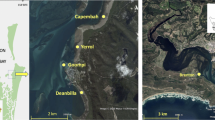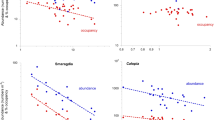Abstract
Few comparative studies of spatial patterns at different scales have examined several species in the same habitat or the same species over a range of habitats. Therefore, variability in patterns among species or among habitats has seldom been documented. This study quantifies spatial patterns of a suite of intertidal snails and a species of barnacle using a range of statistical techniques. Variability in densities was quantified from the scale of adjacent quadrats (over a distance of centimeters) to tens of kilometers. Significant differences in abundances occurred primarily at two spatial scales. Small-scale differences were found at the scales of centimeters or 1–2 m and, for many species on many shores, these accounted for most of the variability in abundances from place to place. These are likely to be determined by behavioural responses to small-scale patches of microhabitat. Large-scale differences in abundance were also found in most species at the scale of hundreds of meters alongshore. These are likely to be due to variation in recruitment (and/or mortality) because of limited dispersal by adults of these species. There was little or no additional variation among shores, separated by tens of kilometers, than was shown among patches of shore separated by hundreds of meters. Identification of the scale(s) at which significant differences in abundance are found focus attention on the processes (and the scales at which these processes operate) that influence patterns of distribution and abundance. Some of the advantages and disadvantages of various procedures are discussed.
Similar content being viewed by others
References
Bell G, Lechowicz MJ, Appenzeller A, Chandler M, DeBlois E, Jackson L, Mackenzie B, Preziosi R, Schallenberg M, Tinker N (1993) The spatial structure of the physical environment. Oecologia 96: 114–121
Brown JH (1984) On the relationship between abundance and distribution of species. Am Nat 124: 255–279
Burdick RK, Graybill FA (1992) Confidence intervals on variance components. Marcel Dekker, New York
Carlile DW, Skalski JR, Batker JE, Thomas JM, Cullinan VI (1989) Determination of ecological scale. Landscape Ecol 2: 203–213
Chapman MG (1986) Assessment of some controls in experimental transplants of intertidal gastropods. J Exp Mar Biol Ecol 103: 181–201
Chapman MG (1994a) Small- and broad-scale patterns of distribution of the upper-shore littorinid, Nodilittorina pyramidalis in New South Wales. Aust J Ecol 19: 83–95
Chapman MG (1994b) Small-scale patterns of distribution and size-structure of the intertidal littorinid, Littorina unifasciata (Gastropoda: Littorinidae) in New South Wales. Aust J Mar Freshwater Res 45: 635–642
Chapman MG, Underwood AJ (1994) Dispersal of the intertidal snail, Nodilittorina pyramidalis. in response to the topographic complexity of the substratum. J Exp Mar Biol Ecol 179: 145–169
Chapman MG, Underwood AJ, Skilleter GA (1995) Variability at different spatial scales between a subtidal assemblage exposed to the discharge of sewage and two control assemblages. J Exp Mar Biol Ecol 189: 103–122
Cliff AD, Ord JK (1981) Spatial processes models and applications. Pion, London
Connell JH (1961) The influence of intraspecific competition and other factors on the distribution of the barnacle Chthamalus stellatus. Ecology 42: 710–722
Connell JH (1985) The consequences of variation in initial settlement versus post-settlement mortality in rocky intertidal communities. J Exp Mar Biol Ecol 93: 11–46
Connell JH, Sousa WP (1983) On the evidence needed to judge ecological stability or persistence Am Nat 121: 789–824
Cullinan VI, Thomas JM (1992) A comparison of quantitative methods for examining landscape pattern and scale. Landscape Ecol 7: 211–227
Dayton PK (1971) Competition, disturbance, and community organization: the provision and subsequent utilization of space in a rocky intertidal community. Ecol Monogr 41: 351–389
De Vogelaere AP (1993) Using a quadrat variance method to quantify patterns of patchiness in a central Californian mussel bed. In: Battershill CN, Schiel DR, Jones GP, Creese RG, MacDiarmid AB (eds) Proceedings of the second international temperate reef symposium. NIWA Marine, Wellington, New Zealand, pp 183–189
Denley EJ, Underwood AJ (1979) Experiments on factors influencing settlement, survival and growth of two species of barnacles in New South Wales. J Exp Mar Biol Ecol 36: 269–293
Downing JA (1991) Biological heterogeneity in aquatic ecosystems. In: Kolasa J, Pickett STA (eds) Ecological heterogeneity. Springer, Berlin Heidelberg New York, pp 160–180
Fairweather PG (1988a) Predation creates halos of bare space among prey on rocky seashores in New South Wales. Aust J Ecol 13: 401–409
Fairweather PG (1988b) Movements of intertidal whelks (Morula marginalba and Thais orbita) in relation to availability of prey and shelter. Mar Biol 100: 63–68
Fairweather PG, Underwood AJ (1991) Experimental removals of a rocky intertidal predator: variations within two habitats on the effects on prey. J Exp Mar Biol Ecol 154: 29–75
Fairweather PG, Underwood AJ, Moran MJ (1984) Preliminary investigations of predation by the whelk Morula marginalba. Mar Ecol Progr Ser 17: 143–156
Frank PW (1981) A condition for a sessile strategy. Am Nat 118: 288–290
Greig-Smith P (1983) Quantitative plant ecology. University of California Press, Berkeley, California
Goodall DW (1974) A new method for analysis of spatial pattern by random pairing of quadrats. Vegetatio 29: 135–146
Hawkins SJ, Hartnoll RG (1980) A study of the small-scale relationship between species number and area on a rocky shore. Est Coast Mar Sci 10: 201–214
Hurlbert SJ (1984) Pseudoreplication and the design of ecological field experiments. Ecol Monogr 54: 187–211
Judge ML, Quinn JF, Wolin CL (1988) Variability in recruitment of Balanus glandula (Darwin, 1854) along the central California coast. J Exp Mar Biol Ecol 119: 235–251
Kennelly SJ (1987) Physical disturbances in an Australian kelp community: I. Temporal effects. Mar Ecol Progr Ser 40: 145–153
Krummel JP, Gardner RH, Sugihara G, O'Neill RV, Coleman PR (1987) Landscape patterns in a disturbed environment. Oikos 48: 321–324
Leduc A, Prairie YT, Bergeron Y (1994) Fractal dimension estimates of a fragmented landscape: sources of variability. Landscape Ecol 9: 279–286
Menge BA (1976) Organization of the New England rocky intertidal community: role of predation competition and environmental heterogeneity. Ecol Monogr 46: 335–393
Menge BA, Lubchenco J, Ashkenas LR (1985) Diversity, heterogeneity and consumer pressure in a tropical rocky intertidal community. Oecologia 65: 394–405
Moran MJ (1985) The timing and significance of sheltering and foraging behaviour of the predatory intertidal gastropod Morula marginalba Blainville (Muricidae). J Exp Mar Biol Ecol 93: 103–114
Morrisey DJ, Howitt L, Underwood AJ, Stark JS (1992) Spatial variation in soft-sediment benthos. Mar Ecol Progr Ser 81: 197–204
Paine RT, Levin SA (1981) Intertidal landscapes: disturbance and the dynamics of pattern. Ecol Monogr 51: 145–178
Palmer MW (1988) Fractal geometry: a tool for describing spatial patterns of plant communities. Vegetatio 75: 91–102
Palmer MW (1992) The coexistence of species in fractal landscapes. Am Nat 139: 375–396
Pielou EC (1969) An introduction to mathematical ecology. Wiley Interscience, New York
Pielou EC (1974) Population and community ecology: principles and methods. Gordon and Breach, New York
Rossi RE, Mulla DJ, Journel AG, Franz EH (1992) Geostatistical tools for modeling and interpreting ecological spatial dependence. Ecol Monogr 62: 277–314
Sarnelle O, Kratz KW, Cooper SD (1993) Effects of an invertebrate grazer on the spatial arrangement of a benthic microhabitat. Oecologia 96: 208–218
Scheffé H (1959) The analysis of variance. Wiley, New York
Searle SR, Casella G, McCulloch CE (1992) Variance components. Wiley Interscience, New York
Sousa WP (1984) Intertidal mosaics: patch size, propagule availability, and spatially variable patterns of succession. Ecology 65: 1918–1935
Steele JH (1978) Spatial pattern in plankton communities. Plenum, New York
Thrush SF, Pridmore RD, Hewitt JE (1994) Impacts on soft-sediment macrofauna: the effects of spatial variation on temporal trends. Ecol Appl 4: 31–41
Underwood AJ (1975) Intertidal zonation of prosobranch gastropods: analysis of densities of four co-existing species. J Exp Mar Biol Ecol 19: 197–216
Underwood AJ (1976) Nearest neighbour analysis of spatial dispersion of intertidal prosobranch gastropods within two substrata. Oecologia 26: 257–266
Underwood AJ (1977) Movements of intertidal gastropods. J Exp Mar Biol Ecol 26: 191–201
Underwood AJ (1980) The effects of grazing by gastropods and physical factors on the upper limits of distribution of intertidal macroalgae. Oecologia 46: 201–213
Underwood AJ (1981a) Techniques of analysis of variance in experimental marine biology and ecology. Annu Rev Oceanogr Mar Biol 19: 513–603
Underwood AJ (1981b) Structure of a rocky intertidal community in New South Wales: patterns of vertical distribution and seasonal change. J Exp Mar Biol Ecol 51: 57–85
Underwood AJ (1994) Things environmental scientists (and statisticians) need to know to receive (and give) better statistical advice. In: Fletcher DJ, Manly BJ (eds) Statistics in ecological and environmental sampling. University of Otago Press, Dunedin, New Zealand, pp 33–61
Underwood AJ (1996) Spatial patterns of variance in densities of intertidal populations. In: Wellings P (ed) Frontiers of population ecology. In press
Underwood AJ, Chapman MG (1989) Experimental analyses of the influences of topography of the substratum on movements and density of an intertidal snail, Littorina unifasciata. J Exp Mar Biol Ecol 134: 175–196
Underwood AJ, Chapman MG (1992) Experiments on topographic influences on density and dispersion of Littorina unifasciata in New South Wales. In: Grahame J, Mill PJ, Reid DG (eds) Proceedings of the third international symposium on littorinid biology. The Malacological Society of London, London, pp 181–195
Underwood AJ, Denley EJ (1984) Paradigms, explanations, and generalizations in models for the structure of intertidal communities on rocky shores. In: Strong DR, Simberloff D, Abele LG, Thistle AB (eds) Ecological communities: conceptual issues and the evidence. Princeton University Press, Princeton, New Jersey, pp 151–180
Underwood AJ, Petraitis PS (1993) Structure of intertidal assemblages in different locations: how can local processes be compared? In: Rickleffs RE, Schluter D (eds) Species diversity in ecological communities: historical and geographical perspectives. University of Chicago Press, Chicago, pp 39–51
Underwood AJ, Denley EJ Moran MJ (1983) Experimental analyses of the structure and dynamics of midshore intertidal communities in New South Wales. Oecologia 57: 202–219
West L (1988) Prey selection by the tropical snail Thais mélones: a study of interindividual variation. Ecology 69: 1839–1854
Winer BJ, Brown DR, Michels KM (1991) Statistical principles in experimental design, 3rd edn. McGraw-Hill, New York
Author information
Authors and Affiliations
Rights and permissions
About this article
Cite this article
Underwood, A.J., Chapman, M.G. Scales of spatial patterns of distribution of intertidal invertebrates. Oecologia 107, 212–224 (1996). https://doi.org/10.1007/BF00327905
Received:
Accepted:
Issue Date:
DOI: https://doi.org/10.1007/BF00327905




